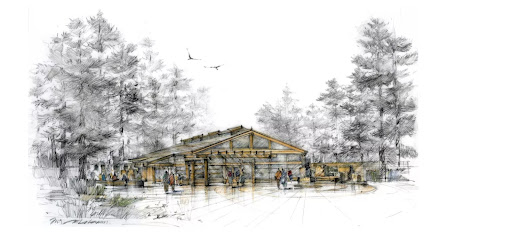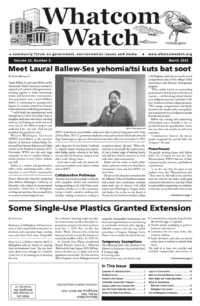by Emma Bjornsrud

WWU’s tribal liaison, Laural Ballew, stands in her office in front of a large poster of the Treaty of Point Elliott. The U.S. government drafted the treaty and convinced tribal leaders from the Puget Sound region to sign over their land and move their tribes onto reservations in 1855.
photo: Emma Bjornsrud
Tandy Wilbur Sr. and Laura Wilbur of the Swinomish Tribal Community worked in regional and national tribal government, traveling together to build relationships within and beyond their communities. Two generations later, Laural (Wilbur) Ballew is continuing her grandparents’ legacies by creating connections between local communities and tribal governments.
“I really think [my grandparents] work through me; it’s their voices that I hear as thoughts, and I know that they’re traveling with me, and helping me build and work every day on the different projects and work that I do,” she said. “And I’m just humbled and grateful for that.”
Western Washington University (WWU) hired Ballew as the executive director of American Indian/Alaska Native and First Nations Relations and Tribal Liaison to the President in January 2019. Previously, WWU was the only large institution on the I-5 corridor without a similar position to serve Native students and staff.
Ballew is a mother and grandmother with a warm, welcoming smile, a determination to serve Native communities and a deep love for her family. Outfitted in colorful Native clothing and jewelry, with fading purple coloring in her hair, she can often be found on campus in her office in the Viking Union.
In her day-to-day work, she advises administrative policies and a Native student club at WWU.
Collaborative Pathways
“Another way I work internally is with the other programs, faculty and researchers having anything to do with Native communities, whether it’s in the curriculum, trying to build a positive working relationship, finding resources or coming in to speak to classes,” she said. “What I do, and how it can benefit the students here, it’s just a broad range of helping faculty and staff here find the resources to work with other tribal communities.”
Ballew said she works to build collaborative pathways to find out what Native communities want, and how WWU can serve them.
She sits on the education committee for the Affiliated Tribes of Northwest Indians and attends their conferences multiple times each year to interact with tribal leaders from Washington, Oregon, Idaho and Alaska. She is also on the Board of Trustees for the Northwest Indian College in Bellingham, where she previously served as department chair of the college’s Tribal Governance and Business Management program.
“What makes Laural an outstanding professional is directly tied to who she is as a person — she has strong cultural identity as an Indigenous person,” said Justin Guillory, Northwest Indian College president. “She’s caring, compassionate and deeply devoted to her family, with a strong desire and commitment to see Indigenous people flourish and prosper.”
Ballew says creating and maintaining relationships comes naturally to her, especially because her grandmother, Laura, was one of her role models, as well as her namesake.
“I watched her wherever she was at, people recognized her and she held a lot of respect,” she said.
Powerhouse
The people working closest with Ballew hold a lot of respect for her, too. Amy Westmoreland, WWU’s director of Multicultural Student Services, said Ballew is a powerhouse.
“I see the care that she gives to our students every day,” Westmoreland said. “They come in, they talk to her, and they trust her. And she has built a really great connection with them in a way that I think is so powerful in supporting our students, so that they can see themselves here; so that they know that there’s somebody who cares, and will keep on trying to make this place better for them.”
Ballew is one of the advisors to the Native American Student Union (NASU), one of WWU’s Ethnic Student Center clubs.
WWU created the tribal liaison position in response to a 2016 letter written by NASU students (1) to the administration to request support for Indigenous students through five prioritized goals:
• Develop and fund a tribal liaison position
• Construct a longhouse on campus
• Verify Native students during enrollment
• Fully fund the Annual Spring Powwow
• Provide government-to-government training between WWU administration and local tribal governments.
Kimberly Werito, one of NASU’s student co-chairs, is in her sixth and final year studying at WWU. She said the addition of the tribal liaison position has benefited Indigenous students on campus, and that Ballew helps them feel informed and involved.
“Laural does a lot of the hefty work with communities, like in the local tribes, but also working with the people [at WWU] and within the City of Bellingham,” Werito said. “So she does all this work, but, at the same time, it’s so important that she also takes into account the students’ view and kind of, the students’ opinion, you could say.”
House of Healing
Ballew formed a Tribal Relations Committee, made up of Native faculty, staff and students, to support the achievement of the goals set by NASU in the 2016 letter. WWU secured $4.5 million in state funding and just over $600,000 from various tribes and organizations in late 2022 for a longhouse-style “house of healing” on campus, meeting the last remaining goal set by the NASU students. WWU received an additional $450,000 in federal funding this year for furnishing and programming costs in the longhouse, which is scheduled for construction Fall 2023.
Ballew formed a longhouse committee and a Coast Salish Elders special advisory group last year to include the Native perspectives in the decision-making and planning for the new building.
In the midst of state Rep. Debra Lekanoff’s efforts to pass legislative funding for WWU’s longhouse during the start of the coronavirus pandemic, Ballew lost her sister to Covid-19.
“I realized that, as we prepared our students to come back out of Covid, nothing was going to be the same, ever,” she said. “And we were going to need to be able to give our students the support and the resources, coming back to campus, and we didn’t know when that was. So, the idea of ‘house of healing’ grew out of that concept.”
Ballew said Indigenous students often have a difficult time leaving home for college, a challenge which has only been exacerbated by the pandemic.
“They leave their communities where they know everyone,” Ballew said. “For generations, their families have lived there and it’s very tight knit, and then they leave that to come to a white institution. I think that’s why we have a hard time with retention of our students, which is why it’s important to have NASU, and this office.”
Werito says the NASU club members are grateful for the care and love Ballew expresses.
“There are many ways that Laural works for the students, and there’s a lot of ways that she shows her care for the community on campus,” Werito said. “The fact that she puts us first, in a way, is what we’re really appreciative of.”
WWU’s House of Healing

The longhouse will be constructed at the south end of the Sehome Hill Arboretum among the trees on ancestral lands. Architectural renderings created by Jones & Jones Architects.
Most large higher education institutions in Washington and Oregon already had some form of Coast Salish longhouse or gathering place for Native students and community members before the Native American Student Union’s 2016 letter requesting a longhouse be built at WWU.
WWU’s “house of healing” is in the planning stages, but is fully funded for construction to begin Fall 2023. The longhouse will include indoor and outdoor gathering spaces with Coast Salish architecture and design to acknowledge the traditional importance of longhouses to the Coast Salish peoples who have lived in the area historically and who still do today.
“The idea of a longhouse, I believe, really gives us action behind the words of land acknowledgement,” Ballew said. “It’s okay to speak a land acknowledgment, but it’s the actions such as this that’s really going to give a lot of credit to [WWU] on this project.”
The “house of healing” will become a place for all Native students, faculty and staff, as well as for all students of color and for members of surrounding communities, Ballew said.
As a familiar, welcoming space for students to find support and community, WWU expects the addition of the longhouse to increase Native American student enrollment by 10 percent.
Endnote:
1. https://www.wwu.edu/nasu-letter Native American Student Union letter, dated May 16, 2016, sent to WWU’s president, the incoming president and the board of trustees.
_________________
Emma Bjornsrud (they/she) graduated from Western Washington University in December with a degree in environmental journalism. Emma lives in Bellingham, working and reporting. You can email them at emmab.journalism@gmail.com.




























